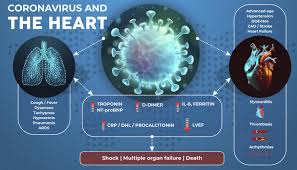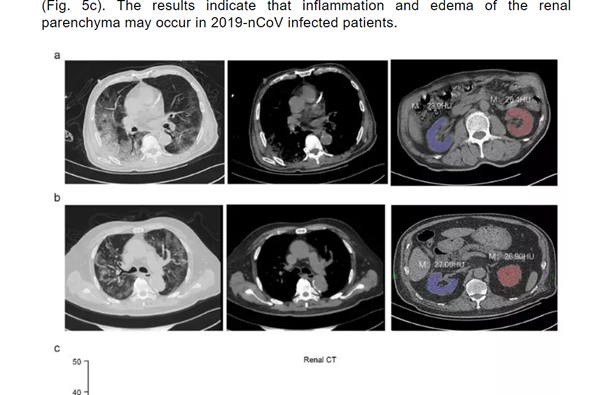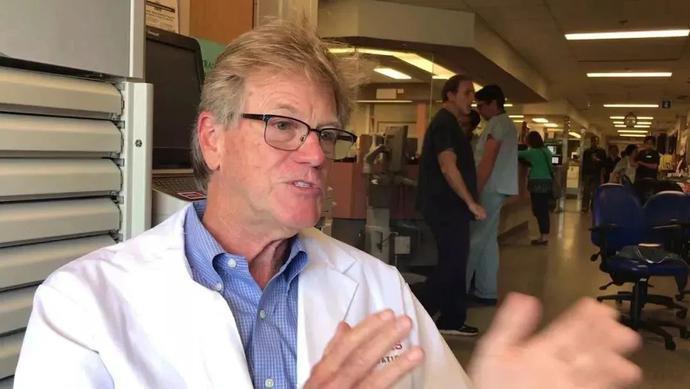Coronavirus: 4 Big Real sequelae of COVID-19

This Contest Between Humans and Coronaviruses Is Far From Over
At present, the global number of new crown cases has approached 23 million, and the number of deaths due to the new Coronaviruses exceeded 772,000! Mankind is helpless with this global epidemic, and the virus is still spreading and spreading in various countries.
Meanwhile, those who survived this catastrophe are still struggling with illness. According to multiple reports, in European and American countries hardest hit by the epidemic, more and more sequelae were found.
1. Damage to the Lung
Recently, many patients “recovered” from new Coronaviruses pneumonia in Italy have experienced physical discomfort. These patients still have sequelae symptoms such as coughing and fatigue after they are cured. After returning to work, some people cannot even take short walks due to shortness of breath and muscle aches!
Italian football superstar Maldini said that although he has recovered from a mild infection, he has left sequelae. “I tried to go to the gym for some training today, but after only 10 minutes, I couldn’t hold on.”
A similar situation also appeared in Hong Kong.
- Disposable Medical Face Masks with Elastic Ear Loop 3 Ply Breathable and Comfortable
- Disposal Protective Clothing for Medical Use
- N95/KN95 Protective Mask with Elastic Ear Loop
- Surgical Mask with Elastic Ear Loop 3 Ply Breathable and Comfortable
- ZeroVirus Space Portable Sterilization Bar
The Infectious Disease Center of Princess Margaret Hospital in Hong Kong followed up the first batch of 10 discharged patients, and found that 3 recovered patients had impaired lung function by 20-30%. The sequelae are mainly manifested as shortness of breath when the pace is fast, unable to exercise normally, and even unable to return to previous work!
Wang Guiqiang, director of the Department of Infectious Diseases at Peking University First Hospital, pointed out that severe lung infections can develop into pulmonary fibrosis. Some severely ill patients will develop lung fibers after they are cured, which affects their daily lives. In the late stage, lung transplantation is the only option.
Moreover, there is currently no specific medicine for pulmonary fibrosis, and the condition is irreversible.
2. Damage to Liver and Kidney
In addition to damage to the lungs, there is increasing evidence that the new coronavirus will also leave sequelae to the liver and kidneys of infected people.
The legendary American rapper Scarface gradually recovered after being infected, and his symptoms have disappeared, except that his kidney failure is getting worse.

He is currently undergoing dialysis treatment, but experts say that recovery from kidney damage may be far away.
Two months ago, studies have pointed out that kidney damage is common in people with new crown infections. This paper, entitled “Caution on Kidney Dysfunctions of 2019-nCoV Patients”, studied 59 cases of 59 infected patients from Wuhan, Huangshi and Chongqing.
It was found that 63% of patients showed symptoms of renal insufficiency, and CT scan showed that 100% of patients had abnormal renal imaging.

Experts in the United Kingdom and Canada also found that 8%-12% of new coronary patients receiving intensive care have liver or kidney failure and need to rely on long-term dialysis treatment to survive.
Huang Bo, deputy director of the Institute of Basic Medicine of the Chinese Academy of Medical Sciences, said that the liver and kidney damage of the infected person may be caused by lung dysfunction.
“When respiratory function is impaired, oxygen exchange is blocked, other organs will be hypoxic, and the kidneys, which are particularly sensitive to oxygen, often suffer severe functional damage.”
3. Damage to the Brain
In addition to the lungs, liver, and kidneys, studies have also found that many recovered patients have very serious central nervous system sequelae.
The neurological study of Huazhong University of Science and Technology on hospitalized patients with new coronary pneumonia showed that more than 30% of the 214 patients had neurological symptoms, which were specifically manifested in three categories:
- One is the central nervous system symptoms such as headache, dizziness, disturbance of consciousness, acute cerebrovascular disease, epilepsy, etc.;
- The second is the symptoms of the peripheral nervous system such as decreased taste, decreased sense of smell, decreased appetite, neuralgia, etc.;
- The third is skeletal muscle injury.
Last month, a 56-year-old patient with new crowns was confirmed to have a new crown virus in the cerebrospinal fluid. The clinical diagnosis was viral encephalitis, and the patient’s central nervous system was affected by the virus. Although this situation is rare, it has occurred many times worldwide.
According to NHK reports, a 24-year-old man living alone in Yamanashi Prefecture, Japan, developed a high fever after contracting the new crown virus, accompanied by headaches and weakness in his limbs.
A few days later, the man was in a coma at home and was diagnosed after being sent to a doctor for emergency treatment. He was also diagnosed with meningitis. The PCR test of cerebrospinal fluid was positive.
Experts said that the meningitis is very likely to be caused by new coronary pneumonia. After the man woke up, he found that his memories of nearly one or two years had been lost!
The attending doctor Moriguchi Takeshi said that this is an important example of the new coronary pneumonia virus invading the central nervous system.
As for why the patient loses memory, experts believe that this is because the part of the patient’s brain responsible for memory is damaged, leading to sequelae such as loss of memory.
According to the observation results of pathological tissues, many infected people have pathological changes in the brain: Brain tissue is hyperemia, edema, and some neurons are degeneration.
There are also many asymptomatic infected people who have blood clots into the cerebrovascular vessels, which eventually cause strokes.
4. Damage to the Heart
The damage caused by the new coronavirus to the heart of patients is not easy to ignore.
A 48-year-old patient from east London revealed that the new coronary pneumonia left her with serious heart damage: “I have been feeling very cold for nine weeks after the cure. Later, the doctor told me that I was suffering from congestive cardiomyopathy (weakened heart function, enlarged heart chamber, and inability to pump blood fully). It may be like this for a lifetime, and most people will get better, but some people may need a pacemaker or even a heart transplant. "
Dr. James Russell, professor of medicine at the University of British Columbia, and several other researchers found that in a survey of 8,000 patients with new coronary pneumonia, more than half of the severely ill patients suffered heart damage and even caused death.

Dr. Russell said that the complications of new coronary patients who have been in the ICU, especially those who have been on a ventilator, will be more serious. They are likely to have problems with their lungs, brain, heart, and muscles in the future.
“Assisted breathing is a double-edged sword.”
Not long ago, the “black face doctor” Hu Weifeng, who was infected with new coronary pneumonia in Wuhan Central Hospital, also suffered from cerebral hemorrhage after using assisted breathing equipment.
His attending doctor pointed out that “going to ECMO is a matter of life and death.” Hu Weifeng unfortunately passed away at 5:45 on June 2 without rescue.
5. Something More
In addition to the above, there are still many recovered patients with new coronary sequelae that have severe central nervous system sequelae.
Many people feel headache, dizziness, confusion, and severe acute cerebrovascular disease, epilepsy, etc.
There are also people’s vision, taste, smell and so on.
Why are there any sequelae after the patients are cured?
In fact, from a medical point of view, to assess whether a disease will have sequelae after it is cured, it generally takes more than 6 months after the disease is cured.
Because the human body has a certain degree of self-repair, in many cases the body organs are damaged by diseases. After the risk factors are eliminated, the body can repair itself and return to normal without any sequelae.
However, if the new coronary pneumonia is evaluated according to this standard, the time is not sufficient, after all, it has been less than half a year since the outbreak.
In addition, human beings are still in the process of gradual understanding of the new coronavirus, and unexpected sequelae are also reasonable.
The French National Academy of Medical Sciences published an analysis report and recommendations on the sequelae of the new coronavirus.
In this report, it was proposed for the first time that some patients with COVID-19 had major sequelae in their heart, kidney, brain and other important organs after recovery.
Professor Patrick Berche, a member of the French Academy of Medical Sciences, said that even mild patients will have sequelae of pulmonary fibrosis.
Pulmonary fibrosis will lead to the decline of respiratory function and increase the risk of respiratory infections. This is simply a time bomb.
In the autopsy report of new coronavirus pneumonia, the professor of autopsy said that lung fibrosis is no longer the lung, and the lung is full of other things.
With pulmonary fibrosis, patients can easily die from respiratory failure. This cause of death is essentially the same as drowning,
A large amount of water poured into the lungs, oxygen could not get in, and the patient struggled to shout for help to the doctor until he died.
If you want to survive, you can only transplant a new lung.
In addition, the report also shows that another new coronary sequelae is myocarditis. A 48-year-old survivor of COVID-19 said in an interview: “For a few weeks after I was cured, I kept feeling cold. The doctor said that I had congestive myocarditis and I would have to fight with this disease for the rest of my life. If the situation worsens, I may even need to install a pacemaker or even a heart transplant.”
Conclusion
The confrontation with the virus is far from over. It is also infectious pneumonia, after SARS patients were cured 17 years ago, more than 70% of the patients were retreated because of humeral head necrosis.
60% of the patients were retreated because of pulmonary fibrosis, and more than 30% of them lost their ability to live because of the new coronavirus.
Today, the cumulative death toll of the new coronavirus has exceeded 780,000, and the number of confirmed cases worldwide has exceeded 22 million. We still don’t know where it will eventually lead humanity.
What we can do is not to underestimate the coronavirus, be on guard and be vigilant at all times and follow the experts and authoritative guides. Go forward bravely, as long as you live, I believe we will win this battle eventually.
